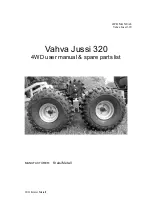
User Manual
Doc. Number: ESO-323064
Doc. Version: 2
Released on:
Page:
32 of 82
Document Classification: Public
4.2.1.2 The distance of the AO natural guide star
Although nominally the field selector allows the selection of the AO NGS
star within 25” from
the nominal position of the science target, the AO NGS star should be as close as possible
to the scientific target, usually closer than 10”: ideally, it is the science target itsel
f.
Depending on the atmospheric conditions, in particular, on the isoplanatic angle,
0
, mild
improvement in the amount of encircled energy can still be obtained if a bright (R < 11) AO
star is used 20-
30” from the scientific target. Targets further away than 20”
from the main
target will need a waiver. This is for the simple reason that the vignetting of the AO system
more than 20 arcseconds from the slit centre is not symmetric.
It is important to recall that the isoplanatic angle decreases with the zenith distance z as
0
(sec z)
-8/5
and increases with wavelength as
0
6/5
. On the other hand the Strehl Ratio
decreases with the angular distance to the AO star
as SR
exp(-(
/
0
)
5/3
).
NOTE: during P108 observations in NGS mode are allowed only if the target is also
the NGS (i.e., only on-axis AO correction)
4.2.1.3 The brightness of the AO star
The intra- and extra-focal pupil of the AO star is imaged on a lenslet array. Each lenslet
feeds an APD that ultimately forwards its signal to the RTC. The flux on an APD is limited
to 1 million counts in order not to damage the devices. The optimal brightness of the AO
star is R
~
11 mag. Brighter stars up to a bright magnitude limit of R
~
0.2 mag can be
dimmed using neutral density filters. Depending on the B-R colour, some stars with slightly
brighter R magnitude can be used. Good correction is still obtained with stars as faint as
R~14 mag under good seeing conditions, while moderate image quality improvement may
be seen with stars as faint as R
~
15 mag under very
good seeing (0.6”)
and coherence time
(5.2 ms). Stars fainter than R
~
15 mag will not result in any improvement and NoAO should
be used, indeed the loop will not close on these targets.
Therefore, the allowed NGS magnitude range is: 0.2 < R < 15 (see 5.2.1 for more details
on the user constrains).
4.2.1.4 The colour of the AO star
The B-R colour is important for precise atmospheric refraction compensation. The AO
system takes into account the di
f
ferential atmospheric refraction between the wavelength
used for the AO and the central wavelength of the spectrograph setup in the calculation of
the tip-tilt mirror orientation. A correct B-R is crucial for accurate centring of the target in the
slit for airmass > 1.2 when guiding with the slit viewer is not possible, as for example, if the
AO star is outside the field-of-view of the slit viewer detector.
4.3 Detector characteristic
The focal plane of CRIRES is equipped with three 2048 x 2048 pixels Hawaii 2RG detector
arrays (6144 x 2048 in total) and a pixel size of
18μm
(see Figure 6).
















































